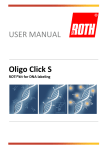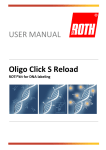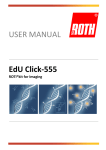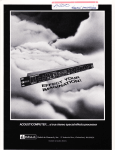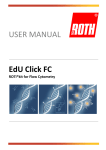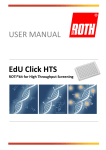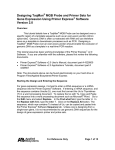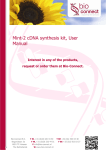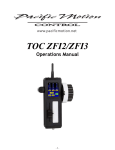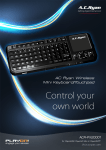Download User manual / Technical Information
Transcript
USER MANUAL Oligo Click M ROTI®kit for DNA labeling ROTI®kit for DNA labeling Carl Roth GmbH + Co. KG Oligo Click M ROTI®kit for DNA labeling For Click Chemistry labeling of up to 100 nmol oligonucleotide containing 1 to 10 alkynes. For research use only: Information in this document is subject to change without notice. Carl Roth GmbH + Co. KG assumes no responsibility for any errors that may appear in this document. Carl Roth GmbH + Co. KG disclaims all warranties with respect to this document, expressed or implied, including but not limited to those of merchantability or fitness for a particular purpose. In no event shall Carl Roth GmbH + Co. KG be liable, whether in contract, tort, warranty, or under any statue or on any other basis for special, incidental, indirect, punitive, multiple or consequential damages in connection with or arising from this document, including but not limited to the use thereof. Cautions: Activator: l g Warning H226-H319-H335 P210-P280-P303+P361+P353-P305+P351+P338-P312a Solvent ROTI®click grade: l g Warning H226-H319-H335 P210-P280-P303+P361+P353-P305+P351+P338-P312a MSDS: the appropriate MSDS can be downloaded from our website www.carlroth.com. Literature citation: When describing a procedure for publication using this product, please refer to it as the Carl Roth’s ROTI®kit for DNA labeling (Oligo Click M). We recommend using the following general protocol for click chemistry labeling of alkynemodified oligonucleotides (from 10 to 100 nmol) with Label-Azides provided by Carl Roth GmbH + Co. KG. 1 Carl Roth GmbH + Co. KG ROTI®kit for DNA labeling Protocol A. General considerations This protocol is optimized for the labeling of up to 100 nmol of a single or double alkyne-modified oligonucleotide via copper(I)-catalyzed azide-alkyne cycloaddition (CuAAc; Click Chemistry). The Reactor M vial contains a stable heterogeneous catalyst, which won’t be dissolved during the reaction. The labeling reaction works more efficiently with concentrated solutions of alkynes (oligo) and azides (Label-Azide, L-N3). The best way to carry out the click reaction is to mix the oligo and the Label-Azide in a minimal amount of solvent. The click reaction is normally accelerated by elevated temperatures and can be finished in 30 min when the reaction temperature is 45 °C. Low reaction temperatures (e.g. 4 °C) can be applied as well in combination with longer reaction time. The reaction time depends on: a) concentration of azide and oligo in the solution; b) reaction temperature; c) stirring and/or mixing of the solution; d) azide steric demand for double-labeling reactions. In the latter case use a prolonged (4 h) reaction time. B. Materials and storage conditions for up to seven (7) independent labeling reactions provided with the Oligo Click M kit. C. Required Material and Equipment – not provided with this kit Alkyne-modified oligonucleotide or Alkyne-modified PCR fragment Centrifuge (optional refrigerated) Microcentrifuge tubes 2 ROTI®kit for DNA labeling Carl Roth GmbH + Co. KG Thermomixer (optional) Ethanol 95% 3 M Sodium-acetate solution (3 M NaOAc) or ammonium-acetate 3 M NH4OAc. D. Work Flow 3 Carl Roth GmbH + Co. KG Step 1 Step 2 Step 3 Step 4 Step 5 Step 6 Step 7 Step 8 ROTI®kit for DNA labeling Vial colour red yellow green blue • Take 6 µL from the blue vial • Add to the green vial • Take 2 µL from the yellow vial • Add to the green vial Name Azide Activator Reactor M Solvent • Add the proper amount of oligonucleotide or DNA into the green vial • Take the proper amount from the red vial • Add to the green vial • Gently mix the green vial • Shortly centrifuge the green vial • Heat to 45 °C under shaking for 1 h • Alternatively, place the green vial in a thermo bath for 1 h at 45 °C • Transfer the liquid phase in a new empty vial • Wash the green vial with 60 µL NaOAc 3 M • Transfer the liquid phases from the green vial into the new empty vial • Add chilled EtOH 95% • Proceed with your preferred work-up 4 ROTI®kit for DNA labeling Carl Roth GmbH + Co. KG E. Click protocol for Oligonucleotide and PCR labeling 1. Preparation of the Oligonucleotide or PCR fragment solution (not provided with the kit) Dissolve the oligonucleotide in the appropriate amount of water to adjust to a 0.1 - 1 mM solution and centrifuge shortly. (Also different concentrations can be used, see Reaction Table at page 7). or Dissolve the PCR fragment in an appropriate amount of water or buffer (avoid EDTA and EDTA-containing buffers) to adjust to ca. 50 – 150 ng/µL solution. 2. Preparation of a 10 mM Label-Azide (L-N3) solution1 (Select your preferred Oligo Click / Azide combination from www.carlroth.com) 2.1 Take the red vial with 1 mg of your selected azide L-N3 out of the freezer and slowly warm up to room temperature. 2.2 Centrifuge shortly to place all L-N3 on the bottom of the red vial. 2.3 Pipette (100,000 / MWL-N3) µL of the solvent (blue vial)2 into the red vial containing the Label-Azide.3 2.4 Vortex the red vial until the Label-Azide is dissolved completely. 2.5 Centrifuge shortly. 3. Performing the click reaction (1-2 min. preparation + 1 h reaction) (Be aware that the catalyst is solid and will not be dissolved during the click reaction!) [Step 1] Pipette 6 µL of the solvent (blue vial) into the green vial with the catalyst [Step 2] Pipette 2 µL of the activator (yellow vial) into the green vial from Step 1 [Step 3] Pipette the appropriate amount of the oligo or DNA solution4 into the green vial from Step 2 [Step 4] Pipette the correct amount5 of Label-Azide solution (L-N3 red vial) reported in the Reaction Table at page 7 into the green vial from Step 3 [Step 5] Vortex the green vial from Step 4 for 10 sec. Centrifuge shortly [Step 6] Place the green vial from Step 5 in a thermomixer at 45 °C for 1 h under gentle shaking (do not exceed 700 rpi) or in a water bath at 45 °C for 1 h. You can run the 1 This preparation is valid for Label-Azides (not included in this kit) soluble in DMSO. You can also use pure water or other solvents compatible with the Label-Azide you selected (see azides under www.carlroth.com) 2 This solvent contains a DMSO/t-BuOH mixture. Download the MSDS from www.carlroth.com (Art.No. 7815). 3 The molecular weight MWL-N3 is given on page 13. See also the calculation sheet on page 8. 4 See “Minimal Oligo Conc.” and “Maximal Reaction Volume” in Reaction Table on page 7. 5 See Reaction Table at page 7 or the calculation sheet on pages 8-10. 5 Carl Roth GmbH + Co. KG ROTI®kit for DNA labeling reaction at room temperature (RT) as well. In this case use a prolonged reaction time (2-4 h). IMPORTANT: Provide always some mixing over the reaction time. The catalyst in the green vial will not be dissolved! 4. Work up (15 – 20 min.) [Step 7] 4.1 Transfer only the liquid phase into a new empty vial 4.2 Wash the green vial containing the solid catalyst with 60 µL of 3M NaOAc 4.3 Collect only the liquid phase from point 4.2 in the new empty vial containing your labeled-oligonucleotide from step 4.1 Proceed with your preferred DNA precipitation or continue with point 5: 5. Precipitation protocol [Step 8] 5.1 Add 1 mL cold ethanol 95% 5.2 Centrifuge for at least 15 min at 4 °C or cool for 1 h at -20 °C and then centrifuge 5.3 Remove the supernatant and dry the residue on air 5.4 Re-dissolve the pellets in the desired amount of water or buffer Your labeled-oligonucleotide or DNA is ready for your experiment / assay. The final product may contain traces of free Label-Azide, although most of the reagents have been removed during the precipitation step. Applicable purification methods: 1. Desalting. 2. RP-HPLC. 3. Gel Electrophoresis. 6 ROTI®kit for DNA labeling Carl Roth GmbH + Co. KG Reaction Table: Use the following table to calculate the amount of reagents (Activator, Solvent and Azide) you need in your oligonucleotide labeling click reactions you in a fast and very reliable way.6 You will need different amounts of Label-Azide – “µL Azide (Red)” column - depending on the amount of oligonucleotide – “Oligo nmol range” column - and the amount of alkynes present in your sequence – “Alkyne content range” column. Add the reagents as described in Point 3 of this protocol. Oligo nmol range Alkyne content range 11 - 30 µL Activator (Yellow) µl Solvent (Blue) µL Azide (Red) Reactor (Green) Minimal Oligo Conc. Maximal reaction volume in µL For a 22mer this range corresponds to 2.5 – 6.6 OD or 73 – 200 µg 1-2 3-6 7 - 10 31 - 50 2 2 2 6 6 6 12 36 60 M M M 0.1 mM 0.1 mM 0.1 mM 150 300 300 For a 22mer this range corresponds to 7.0 - 11 OD or 205 - 330 µg 1-2 3-6 7 - 10 51 - 70 2 2 2 6 6 6 20 60 100 M M M 0.1 mM 0.1 mM 0.1 mM 300 300 300 For a 22mer this range corresponds to 11 - 16 OD or 337 - 462 µg 1-2 3-6 7 - 10 2 2 2 6 6 6 28 84 140 M M M 0.1 mM 0.1 mM 1.0 mM 300 300 300 For a 22mer this range corresponds to 16 - 22 OD or 337 - 470 µg 71-100 1-2 3-6 7 - 10 2 2 2 6 6 6 40 120 200 6 M M M 0.1 mM 0.1 mM 1.0 mM 300 300 300 For a detailed calculation see page 8 of this user manual. Use the Azide Table on page 10 in order to minimize the amount of Label-Azide required in your labeling reaction. 7 Carl Roth GmbH + Co. KG ROTI®kit for DNA labeling Appendix F. Calculation Sheet 1 Preparation of a 10 mM Label-Azide (L-N3) Solution To calculate the amount of solvent VL in µL to be added to 1 mg of Label-Azide (L-N3) to prepare a 10mM solution divide 100,000 by the molecular weight of the Label-Azide (MWL-N3). E.g.: m = Label-Azide = FAM-N3 1 mg MWL-N3 = 458.4 g/mol VL = 100,000 / 458.4 = 218.2 µL cazide = 10 mM 1.1 Take the red vial with 1 mg Label-Azide out of the freezer and slowly warm up to room temperature. 1.2 Centrifuge shortly to place all the Label-Azide on the bottom of the vial. 1.3 Pipette VL (µL calculated in 1) of solvent from the blue vial into the red vial with the Label-Azide. 1.4 Vortex the red vial until the Label-Azide is dissolved completely. 1.5 Centrifuge shortly. This solution can be stored at -20 °C in the dark for several months (refer to the Label-Azide Data-Sheet). The azide functionality is very stable and does not hydrolyze in water. G. Click reaction calculation sheet Use the Reaction Table on page 7 to read out the amount of Label-Azide (L-N3) to be used in your experiment. Use the Azide Table on page 10 if you need to minimize the amount of Label-Azide used in your labeling reaction. Below you can read how you can calculate those values yourself: 1. For oligonucleotide labeling: 1.1 Calculate the amount of oligonucleotide noligo in nmol noligo [nmol] = m [ng] / MW [g/mol] n [nmol] = c [mM] x V [µL] 1.2 If you have a concentration c [ng/µL] divide this value by the molecular weight MW [g/mol] of your oligo in order to obtain the total concentration in nmol/µl. Multiply this value by the total volume in µl to obtain the total amount of your oligo noligo in nmol. Example: oligonucleotide containing three (3) alkynes and the following specifications: coligo = 250 ng/µL MWoligo = 6500 g/mol 8 ROTI®kit for DNA labeling Carl Roth GmbH + Co. KG Total volume = Voligo = 150 µL Total amount = noligo = (250 / 6500) x 150 = 5.8 nmol 1.3 Multiply noligo by the total amount of incorporated alkynes in order to obtain nalkynes in nmol. Oligo containing 3 alkynes noligo = 5.8 nmol nalkynes = 5.8 x 3 = 17.4 nmol 1.4 The click reaction requires only two equivalents of azide. Multiply nalkynes x 2 to obtain nazide in nmol. nazide = 17.4 x 2 = 34.8 nmol 1.5 Divide nazide by the azide concentration cazide = 10 mM in order to obtain the amount of azide (Vazide in µL) to be used in the reaction. Vazide = nazide / cazide = 34.8 / 10 = 3.5 µL Use 3.5 µL of Label-Azide 10 mM in your click reaction. 2. For PCR labeling: Calculate the amount of Azide (L-N3) that you want to use for labeling your alkyne-modified DNA. The final labeling rate of the DNA can be tuned by the amount of azide used and has to be adjusted for every new DNA template. 2.1 Measure the DNA concentration cDNA [ng/µL] after PCR workup with a photometer. 2.2 Calculate the molecular weight MW (g/mol) of your DNA template (MWDNA): MWDNA [g/mol] = 600 g/mol x bp 600 g/mol is the average mass of a basepair bp = number of basepairs in your DNA template 2.3 Calculate the total amount of DNA nDNA in nmol present in your sample: nDNA [nmol] = cDNA [ng/µL] x VDNA [µL] / MW [g/mol] cDNA [ng/µL]: measured in 2.1 MWDNA [g/mol]: calculated in 2.2 VDNA [µL] = volume of your sample (measure it with a pipette) 2.4 Calculate the total amount of terminal alkyne modifications nalkynes in nmol in your DNA. This amount corresponds to the amount of Thymidines in your DNA if dTTP was replaced by C8-Alkyne-dUTP during PCR: nalkynes [nmol] = [(bp x AT-content %) / 100] x nDNA [nmol] bp = number of basepairs in your DNA template AT-content % = percentage of A’s and T’s in your DNA nDNA (nmol) = calculated in 2.3 If dCTP was replaced by C8-Alkyne-dCTP during PCR then calculate nalkynes in nmol in your DNA as follow: 9 Carl Roth GmbH + Co. KG ROTI®kit for DNA labeling nalkynes [nmol] = (bp x GC-content %) / 100 x nDNA [nmol] bp = number of basepairs in your DNA template GC-content % = percentage of G’s and C’s in your DNA nDNA [nmol] = calculated in 2.3 2.5 Calculate the amount of Label-Azide nazide in nmol for labeling the alkyne-modified DNA. Labeling rates depend on the amount of Label-Azide applied. Normally 1 – 30 equivalents of azide are used, resulting in labeling rates of up to 20 % and more! nazide [nmol] = nalkynes [nmol] x k nalkynes [nmol] = calculated in 2.4 k = equivalents of azide (normally 1 – 30) Vazide (Label-Azide; 10 mM) = nazide [nmol] / 10 nmol/µL Add Vazide [µL] to your click reaction. H. Azide Table Use these tables to read out the minimum amount of Label-Azide needed in your labeling click reaction, in order to reduce the Label-Azide consumption when needed. For example, if you have 65 nmol of an oligonucleotide (nmol Oligo = 65) containing 4 alkynes in the sequence (Nr. of Alkynes = 4) then use 52 µL of the Label-Azide 10 mM solution.7 Nr. of Alkynes 1 2 3 4 5 6 7 8 9 10 nmol Oligo µL Azide µL Azide µL Azide µL Azide µL Azide µL Azide µL Azide µL Azide µL Azide µL Azide 15 3 6 9 12 15 18 21 24 27 30 20 4 8 12 16 20 24 28 32 36 40 25 5 10 15 20 25 30 35 40 45 50 30 6 12 18 24 30 36 42 48 54 60 35 7 14 21 28 35 42 49 56 63 70 40 8 16 24 32 40 48 56 64 72 80 45 9 18 27 36 45 54 63 72 81 90 50 10 20 30 40 50 60 70 80 90 100 55 11 22 33 44 55 66 77 88 99 110 60 12 24 36 48 60 72 84 96 108 120 65 13 26 39 52 65 78 91 104 117 130 70 14 28 42 56 70 84 98 112 126 140 75 15 30 45 60 75 90 105 120 135 150 80 16 32 48 64 80 96 112 128 144 160 85 17 34 51 68 85 102 119 136 153 170 90 18 36 54 72 90 108 126 144 162 180 95 19 38 57 76 95 114 133 152 171 190 100 20 40 60 80 100 120 140 160 180 200 7 The amount of Label-Azide reported in the Reaction Table at page 7 are for this example 84 µL, which cover the range between 51 and 70 nmol oligo containing from 3 to 6 alkynes in the sequence. 10 ROTI®kit for DNA labeling Carl Roth GmbH + Co. KG Troubleshooting If the labeling is not complete then increase the reaction time and eventually the reaction temperature (recommended for multi labeling reactions and/or for azides with high steric demand). 11 Carl Roth GmbH + Co. KG ROTI®kit for DNA labeling Your notes: 12 Carl Roth GmbH + Co. KG ROTI®kit for DNA labeling Ordering information: (for detailed kit content see Table under B.) ROTI®kits for DNA labeling: Product number Product Used Label-Azide Reactor 7764.1 Oligo Click S Reload - 9 x 2,5 mg 7765.1 Oligo Click M Reload - 9 x 5 mg 7766.1 Oligo Click S-488 7767.1 Oligo Click M-488 7769.1 Oligo Click S-555 7770.1 Oligo Click M-555 7771.1 Oligo Click S-Biotin 7772.1 Oligo Click M-Biotin 6-FAM-Azide MWL-N3 = 458.43 g/mol 6-FAM-Azide MWL-N3 = 458.43 g/mol 5-TAMRA-Azide MWL-N3 = 512.56 g/mol 5-TAMRA-Azide MWL-N3 = 512.56 g/mol Biotin Azide MWL-N3 = 326.42 g/mol Biotin Azide MWL-N3 = 326.42 g/mol To place your order, please contact us: Phone: +49 (0)721/5606-0 Fax: +49 (0)721/5606-149 Email: [email protected] 13 7 x 2,5 mg 7 x 5 mg 7 x 2,5 mg 7 x 5 mg 7 x 2,5 mg 7 x 5 mg Carl Roth GmbH + Co. KG Phone: +49 (0)721/5606-0 Schoemperlentraße 3-5 Fax: 76185 Karlsruhe, Germany Email: [email protected] +49 (0)721/5606-149
















